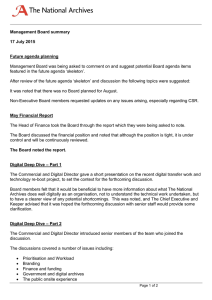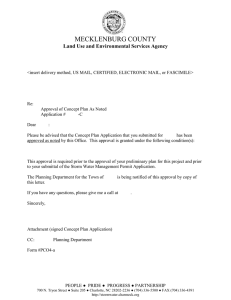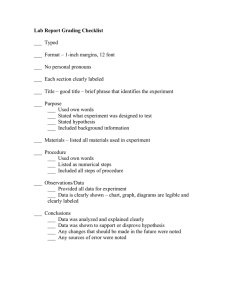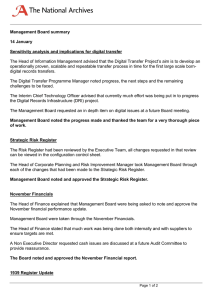Document 14292160
advertisement
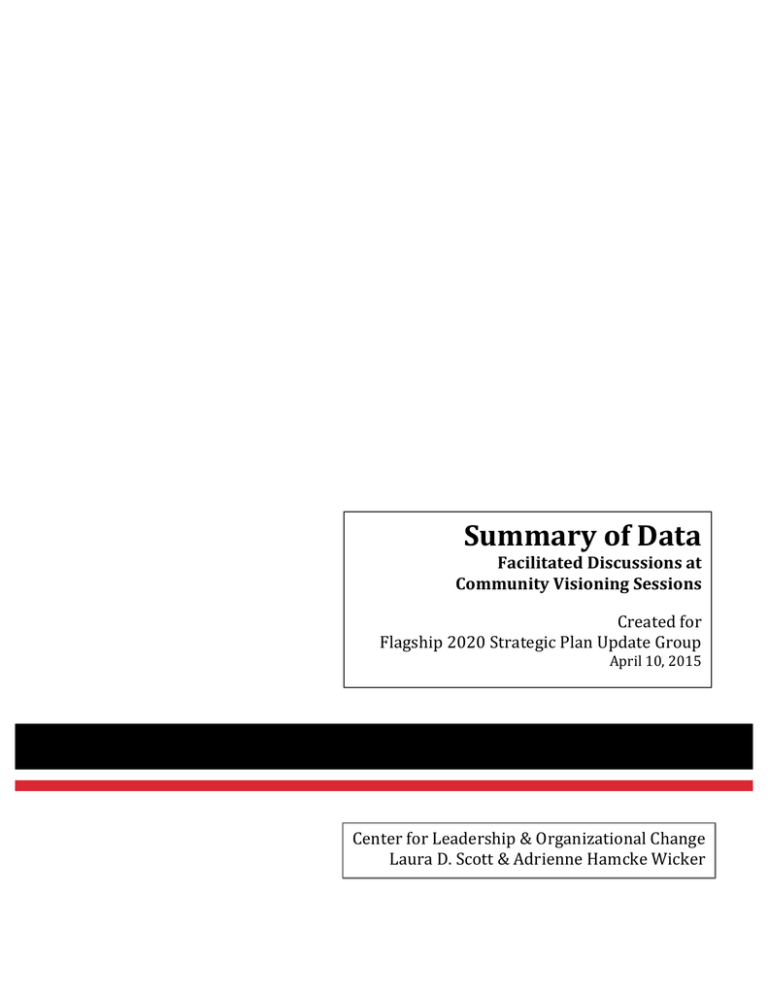
Summary of Data Facilitated Discussions at Community Visioning Sessions Created for Flagship 2020 Strategic Plan Update Group April 10, 2015 Center for Leadership & Organizational Change Laura D. Scott & Adrienne Hamcke Wicker Background and Process Four public “community visioning sessions,” open to faculty, staff, and students, were conducted in March 2015. The process was designed both to generate information about the desired future for the university and to provide an open and transparent process. Each session had a focus (the University as: magnet for educating the most promising next generation; leader in research, innovation, and creative endeavors; economic driver for the state of Maryland; critically engaged community partner). There were 245 participants who completed written worksheets and participated in facilitated discussions. More than 1,500 data points were created from the responses to the discussion questions. The data were analyzed and sorted into themes, first by session/topic, then across sessions. The resulting cross-­‐topic themes were developed into seven primary themes, which were presented to the work group on April 10, 2015. Primary Themes Collaborations, partnerships, and relationships: The growing importance of being able to work in relationship, both collaboratively and in partnership, was noted across all themes and all questions, as was the necessity of institutionalizing the supporting mechanisms, incentives, expectations and resources. Most external efforts suggested were for College Park, but there was also a specific focus on creating partnerships with K-­‐12 education in the county, with goals of strengthening the schools and creating a pipeline for future students. Increased public/private and public/public partnerships were recommended, and some envisioned a thriving research arena with business, government, and university participation; others noted the value of strong networks with federal and state agencies. Some participants called for an institution open and accessible to private industry research. These relationships were defined as friendly, reciprocal, long-­‐term, and outcome-­‐ focused. Participants described “permeable borders,” “routine boundary crossing,” and “engaged citizen students” as desired outcomes. Vibrant College Park: Recognition of the critical importance of the surrounding area is universal. Participants discussed the need for tangible improvements in housing, transportation, education, and amenities. Non-­‐tangible, “lived experience” desires were enumerated: be a destination location; feel like a college town; be a safe place with people out and about; be where people want to live and where students, faculty and staff are members of the community. Participants imagine working in mutually beneficial partnership with College Park as a trusted partner. -­‐ 2 -­‐ Transformed student learning experience: Building excitement and engagement through different ways of learning and teaching was an energizing theme. Every student having a research, entrepreneurial, or creative project about which they are passionate and proud; having learning opportunities outside the classroom; being able to participate in an innovative learning program or experience are desired outcomes. Participants imagine an educational experience that is adaptable, flexible, and personal, with easy availability of interdisciplinary, “create-­‐your-­‐own” and “more trendy” majors. The value of STEM and non-­‐STEM discipline integration was noted. Exceptional infrastructure, innovatively used: The critical importance of infrastructure and its innovative use was explored in detail. Up-­‐to-­‐date, universally available, and fully operational technology is desired. Participants imagined all buildings appropriately equipped and frequently updated and upgraded with technology that supports innovative teaching and learning. Better technical support of administrative and student services (particularly advising) was also noted. Upgrading existing campus buildings was frequently mentioned, particularly where lab availability and quality is key to recruitment and “state-­‐of-­‐the-­‐art” and “innovative” are expectations. Having more new buildings and better maintaining those that exist, and aligning all building and maintenance with sustainability standard, were noted. Creative, flexible, and collaborative use of space, particularly in ways that break down divisions and foster collaborations, is supported. Some desire more interdisciplinary, entrepreneurial, and/or innovative spaces (e.g. Makerspaces) that are bold, alive, and destinations for enterprise and collaboration. Funding, finances, and money Discussion of money, finances and funding was universal. Participants strongly expressed need for change in the financial situation and structure. Desire for a long-­‐ term, sustainable funding model was wide-­‐spread, as was the desire to see resource allocation, with almost equal numbers proposing more even allocation (“get rid of the haves and have-­‐nots”) and others advocating selectivity (“strategic financial support”). Incentives for desired behaviors (collaboration, risk-­‐taking, innovation, etc.) were occasionally noted. There was support for stabilizing or increasing state funding; there was likewise support for decreasing reliance on state funding by developing alternative sources. Strategies include building a massive endowment, innovating with crowd-­‐funding or income from university-­‐related start-­‐up companies, and diversifying to include corporate, non-­‐profit, foundation, and government funding. Wide-­‐ranging discussion about student support included: more scholarships, both need-­‐ and merit-­‐based; more financial aid; strategies to keep tuition low; increased -­‐ 3 -­‐ or full funding for graduate students; more for targeted groups, including top MD students, Banneker-­‐Key, study abroad, DREAMers, and under-­‐represented populations. The people and culture: The people who do the work of the university and the culture in which they do so were noted. Support for: competitive faculty pay; an adequate number of staff adequately compensated monetarily and non-­‐monetarily; a culture of advancement, development, pipeline building and succession planning was evident. Increasing diversity among students, staff, and faculty was noted, but the need for even more diversity was uniformly noted. An increase in the number of international students and in the availability and prevalence of foreign language instruction has some support. Alumni had a significant role in every discussion, with reciprocal relationships in support of networking, student mentoring, and employment desired. Building stronger relationships earlier (and with better tracking) was an identified need. Different ways of working together are desired: more collaboration, improved interpersonal communication, and decreased bureaucracy were mentioned. Transparency in systems, data, and governance is valued, as is having a universally known common vision that remains constant through changes in leadership. A qualitatively better “lived experience” with visible respect for ideas, buildings, and people is desired. Being where people are friendly and happy and encouraging others to come is valued, as is a culture of excellence. Rankings, ratings, reputation, perceptions: The university has moved up—and should continue to—in a number of rankings and ratings, both widely accepted (national academies, number of Nobel Laureates, NSF, etc.) and less universally so (U.S. News and World Report, NCAA rankings, “Prettiest College Campus” lists, etc.). There is a desire to become the peer to which others aspire. Even more: award-­‐winning and notable faculty research; high quality applicants; top students choosing UMD; and students successful here and after graduating are wanted. Non-­‐academic markers, infrequently noted, included: national sports champions; diversity benchmark; a model for stopping sexual assault. More sharing of good news and celebration of successes already achieved would be appreciated. Having visible, quoted experts who are seen “everywhere we look” (e.g. CNN and in the New York Times) is valued. First-­‐rate marketing and branding as a first-­‐rate research institution is needed. -­‐ 4 -­‐
